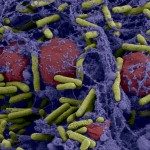Link to Pubmed [PMID] – 10973945
J. Biol. Chem. 2000 Oct;275(43):33197-200
This study provides evidence that the differences in membrane composition found from one cell type to another can represent a limiting factor to recovering the functionality of transmembrane proteins when expressed in heterologous systems. Restoring the properties of the human mu-opioid receptor in yeast (Saccharomyces cerevisiae), similar to those observed in native cells, was achieved by replacing ergosterol from yeast by cholesterol, which is normally found in mammalian plasma membranes. The results suggest that these two sterols have opposite effects with respect to the ligand binding function of the receptor. Ergosterol was found to constrain the mu-opioid receptor in an inactive state in yeast plasma membranes and cannot replace cholesterol in activating it. These data differ from previous works dealing with the function of related G-protein-coupled receptors (GPCR) in ergosterol-enriched membranes. This suggests that structural requirements of GPCR with respect to their modulation by lipid components differ from one protein to another. As a consequence, we assume that the presence of appropriate lipids around transmembrane proteins determines their function. This highlights the functional significance of lateral heterogeneities of membrane components within biological membranes.

